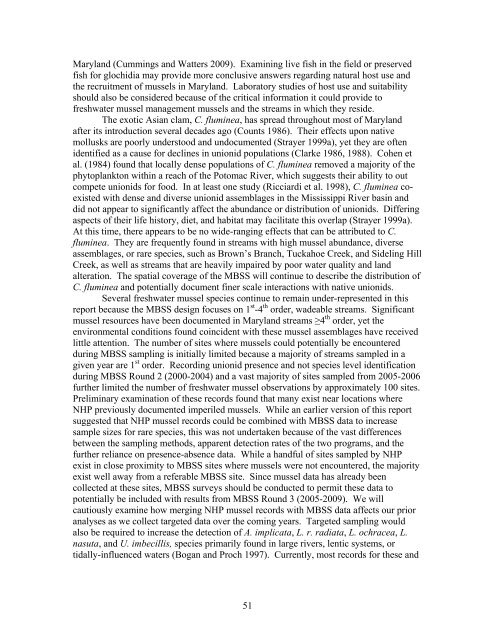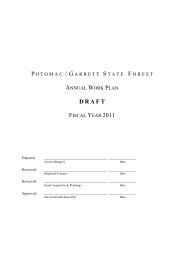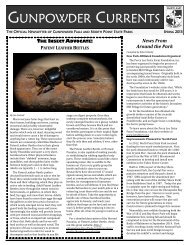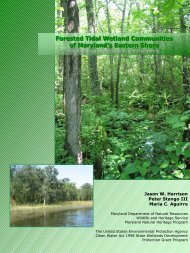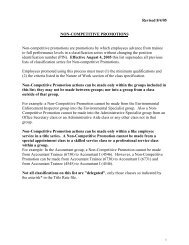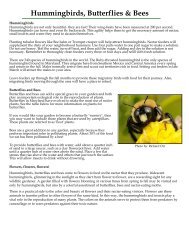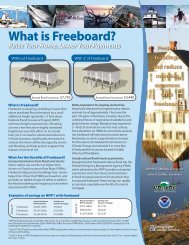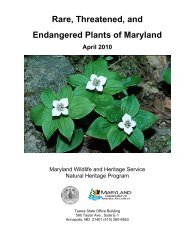Freshwater mussel records collected by the Maryland Department of ...
Freshwater mussel records collected by the Maryland Department of ...
Freshwater mussel records collected by the Maryland Department of ...
You also want an ePaper? Increase the reach of your titles
YUMPU automatically turns print PDFs into web optimized ePapers that Google loves.
<strong>Maryland</strong> (Cummings and Watters 2009). Examining live fish in <strong>the</strong> field or preserved<br />
fish for glochidia may provide more conclusive answers regarding natural host use and<br />
<strong>the</strong> recruitment <strong>of</strong> <strong>mussel</strong>s in <strong>Maryland</strong>. Laboratory studies <strong>of</strong> host use and suitability<br />
should also be considered because <strong>of</strong> <strong>the</strong> critical information it could provide to<br />
freshwater <strong>mussel</strong> management <strong>mussel</strong>s and <strong>the</strong> streams in which <strong>the</strong>y reside.<br />
The exotic Asian clam, C. fluminea, has spread throughout most <strong>of</strong> <strong>Maryland</strong><br />
after its introduction several decades ago (Counts 1986). Their effects upon native<br />
mollusks are poorly understood and undocumented (Strayer 1999a), yet <strong>the</strong>y are <strong>of</strong>ten<br />
identified as a cause for declines in unionid populations (Clarke 1986, 1988). Cohen et<br />
al. (1984) found that locally dense populations <strong>of</strong> C. fluminea removed a majority <strong>of</strong> <strong>the</strong><br />
phytoplankton within a reach <strong>of</strong> <strong>the</strong> Potomac River, which suggests <strong>the</strong>ir ability to out<br />
compete unionids for food. In at least one study (Ricciardi et al. 1998), C. fluminea coexisted<br />
with dense and diverse unionid assemblages in <strong>the</strong> Mississippi River basin and<br />
did not appear to significantly affect <strong>the</strong> abundance or distribution <strong>of</strong> unionids. Differing<br />
aspects <strong>of</strong> <strong>the</strong>ir life history, diet, and habitat may facilitate this overlap (Strayer 1999a).<br />
At this time, <strong>the</strong>re appears to be no wide-ranging effects that can be attributed to C.<br />
fluminea. They are frequently found in streams with high <strong>mussel</strong> abundance, diverse<br />
assemblages, or rare species, such as Brown’s Branch, Tuckahoe Creek, and Sideling Hill<br />
Creek, as well as streams that are heavily impaired <strong>by</strong> poor water quality and land<br />
alteration. The spatial coverage <strong>of</strong> <strong>the</strong> MBSS will continue to describe <strong>the</strong> distribution <strong>of</strong><br />
C. fluminea and potentially document finer scale interactions with native unionids.<br />
Several freshwater <strong>mussel</strong> species continue to remain under-represented in this<br />
report because <strong>the</strong> MBSS design focuses on 1 st -4 th order, wadeable streams. Significant<br />
<strong>mussel</strong> resources have been documented in <strong>Maryland</strong> streams ≥4 th order, yet <strong>the</strong><br />
environmental conditions found coincident with <strong>the</strong>se <strong>mussel</strong> assemblages have received<br />
little attention. The number <strong>of</strong> sites where <strong>mussel</strong>s could potentially be encountered<br />
during MBSS sampling is initially limited because a majority <strong>of</strong> streams sampled in a<br />
given year are 1 st order. Recording unionid presence and not species level identification<br />
during MBSS Round 2 (2000-2004) and a vast majority <strong>of</strong> sites sampled from 2005-2006<br />
fur<strong>the</strong>r limited <strong>the</strong> number <strong>of</strong> freshwater <strong>mussel</strong> observations <strong>by</strong> approximately 100 sites.<br />
Preliminary examination <strong>of</strong> <strong>the</strong>se <strong>records</strong> found that many exist near locations where<br />
NHP previously documented imperiled <strong>mussel</strong>s. While an earlier version <strong>of</strong> this report<br />
suggested that NHP <strong>mussel</strong> <strong>records</strong> could be combined with MBSS data to increase<br />
sample sizes for rare species, this was not undertaken because <strong>of</strong> <strong>the</strong> vast differences<br />
between <strong>the</strong> sampling methods, apparent detection rates <strong>of</strong> <strong>the</strong> two programs, and <strong>the</strong><br />
fur<strong>the</strong>r reliance on presence-absence data. While a handful <strong>of</strong> sites sampled <strong>by</strong> NHP<br />
exist in close proximity to MBSS sites where <strong>mussel</strong>s were not encountered, <strong>the</strong> majority<br />
exist well away from a referable MBSS site. Since <strong>mussel</strong> data has already been<br />
<strong>collected</strong> at <strong>the</strong>se sites, MBSS surveys should be conducted to permit <strong>the</strong>se data to<br />
potentially be included with results from MBSS Round 3 (2005-2009). We will<br />
cautiously examine how merging NHP <strong>mussel</strong> <strong>records</strong> with MBSS data affects our prior<br />
analyses as we collect targeted data over <strong>the</strong> coming years. Targeted sampling would<br />
also be required to increase <strong>the</strong> detection <strong>of</strong> A. implicata, L. r. radiata, L. ochracea, L.<br />
nasuta, and U. imbecillis, species primarily found in large rivers, lentic systems, or<br />
tidally-influenced waters (Bogan and Proch 1997). Currently, most <strong>records</strong> for <strong>the</strong>se and<br />
51


